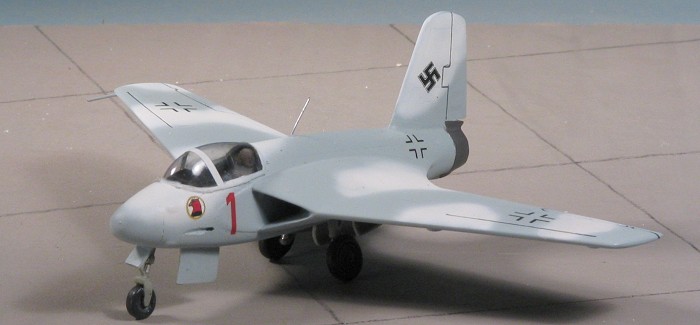
| KIT #: | AM 2065 |
| PRICE: | € 19.00 plus shipping from www.airmodel.de |
| DECALS: | None |
| REVIEWER: | Scott Van Aken |
| NOTES: | Resin kit with vacuform canopy |

| ALTERNATE HISTORY |
"I really love my job", thought Feldwebel Michel Stoner as he banked and soared above the sparkling blue waters. Posted to II./JG 47, garrisoned at Gibraltar, which was overtaken by the Spanish during the dark years of 1942, his sole duty was to thwart any incoming aerial attack from the Allies, who were currently having enough troubles of their own in Morocco. "I only wish that our flight hadn't been chosen to test these new camouflage schemes. 'Clouds', that's what the RLM calls this one. Any idiot knows that there are rarely clouds in this part of the Mediterranean. I much preferred the nice, overall light blue". While continuing to mutter to himself about the paint scheme, he thinks back on the current situation of the war while flying his patrol route
With most of Europe under control,
the Soviets pushed into the Urals, Near East oil flowing into refineries,
and the Allies basically booted out of Northern Africa, the Reich seemed to
be on its way to that thousand years that Hitler had promised. The British
were holed up and surrounded with supplies barely getting through the
U-boat blockade, yet it was considered too risky to try to invade them, so
they've been hanging on for seven years. With them contained, Germany, and
her many 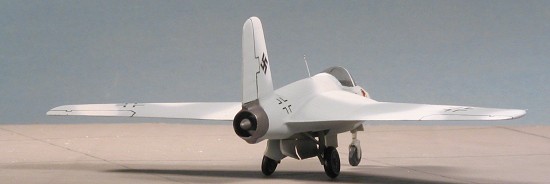 allies from the newly formed countries of India, Tunisia, Morocco,
New Russia, and Algeria fully into the Axis pact. It was even surprising
that Franco decided to join in on things back in 1943. No, things were not going
badly at all.
allies from the newly formed countries of India, Tunisia, Morocco,
New Russia, and Algeria fully into the Axis pact. It was even surprising
that Franco decided to join in on things back in 1943. No, things were not going
badly at all.
The Allies were still causing a lot of trouble what with the US continually supplying what was left of the Commonwealth, but with the Japanese fully consolidated in the Pacific and draining supplies in their holding action against the US and Australia, all the Germans and Italians need to do was to hold things as they have been for the last three years in order to build up for continued expansion. It was all thanks to the fall of Egypt and defeat of the British in Egypt and the Near East that set things into motion. With the Italians able to do a credible job holding on to things, Germany was able to concentrate on the Soviets and consolidating gains. It is incredibly lucky that Germany and the US did not declare war until 1943 as that would have upset the timetable quite a bit. Instead, they concentrated on Japan. The Japanese were less than thrilled that the European Axis partners abrogated their promise to go to war after Pearl Harbor, but all is fair.........
Anyway, Michel was delighted to be up and flying. From this vantage point, Gibraltar looked tiny and he could see over to the Atlas Mountains in Morocco. Just on the other side of those, there was a major stalemate going on with the Allies unable to get past the entrenched German and Moroccan army in the foothills. However, it was generally from that direction or from the Azores, which had been taken over by a British invasion in 1943, that any sort of aerial attack had come. Besides, there was really little in Spain that was of interest to Allied planners.
The aircraft that Feldwebel Stoner
was currently piloting, was an adaptation of Willy Messereschmitt's rocket
powered Me-163. Dr Lippisch reasoned that a
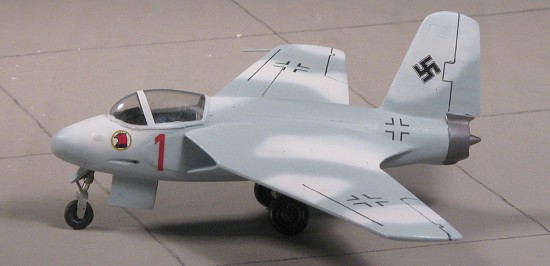 turbojet powered version may
not be as quick in the climb as the 163, but it would be much less
dangerous to the pilot and provide a lot more flying time than the few
minutes given by the 163. Not only that, but his design also included
proper landing gear so that the dubious trolley used by the 163 was no
longer needed. Even with all this, the most that one could expect in terms
of flight time was about 20-25 minutes, even with the more reliable and
more fuel efficient Heinkel HeS 011 turbojet. Just a few minutes were all
that was really needed. The twin 30mm cannon were enough to tear off the
wings of Allied bombers; including the super long range B-29 Superfortress
that were now pretty much what the Americans were using. The Brits had
developed the Lincoln from the Lancaster and while not quite as high flying
as the B-29, was still able to fly a respectable distance with a
considerable load.
turbojet powered version may
not be as quick in the climb as the 163, but it would be much less
dangerous to the pilot and provide a lot more flying time than the few
minutes given by the 163. Not only that, but his design also included
proper landing gear so that the dubious trolley used by the 163 was no
longer needed. Even with all this, the most that one could expect in terms
of flight time was about 20-25 minutes, even with the more reliable and
more fuel efficient Heinkel HeS 011 turbojet. Just a few minutes were all
that was really needed. The twin 30mm cannon were enough to tear off the
wings of Allied bombers; including the super long range B-29 Superfortress
that were now pretty much what the Americans were using. The Brits had
developed the Lincoln from the Lancaster and while not quite as high flying
as the B-29, was still able to fly a respectable distance with a
considerable load.
Returning to base, his aircraft was refueled and put back into the 'ready' flight pens. These were covered shelters with bunkers on the side and openings in the front and back to allow quick entry and exit of the planes. Pilots sat nearby in beach chairs, chatting and passing the time with cards and cool drinks (non-alcoholic, of course). About the only time they were scrambled of late was for the usual recce bird. While not exactly a backwater, Gibraltar was considered to be pretty easy duty.
Suddenly, as the sun was setting, the klaxons started to blare and pilots rushed for their aircraft. "Another drill." thought Stoner as his mechanic fired up his engine and helped get him into his gear. He had to be careful entering the cockpit so that he wouldn't accidentally FOD the engine as the intakes were so very close by. Settling in and adjusting his helmet and radio, the ground controller gave them clearance to taxi and then take off. 'Fly a heading of 210 degrees at an altitude of 5,000 meters', came the instructions in his headset. Not too high and from an odd direction.
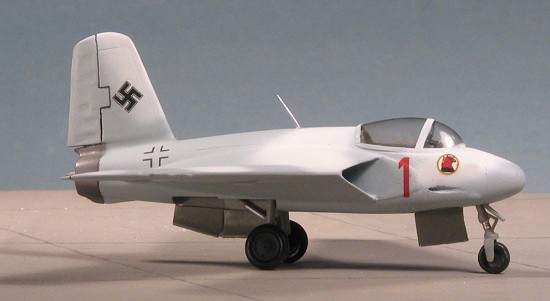 Heading out over the Atlantic, Stoner
and his flight suddenly saw a glint from near the surface. Not sure if it
was the sea or not, he called to his flight to be watchful. As they flew
closer, they could see that there was a formation of aircraft, painted in a
blue grey color, flying close to the water. It was only the glint off the
canopies that gave them away. They were B-29s! A most unexpected place to
find what are planes designed to fly at over 10,000 meters, yet here they
were, trying to sneak their way in under the radar.
Heading out over the Atlantic, Stoner
and his flight suddenly saw a glint from near the surface. Not sure if it
was the sea or not, he called to his flight to be watchful. As they flew
closer, they could see that there was a formation of aircraft, painted in a
blue grey color, flying close to the water. It was only the glint off the
canopies that gave them away. They were B-29s! A most unexpected place to
find what are planes designed to fly at over 10,000 meters, yet here they
were, trying to sneak their way in under the radar.
Stoner called the base to send more aircraft as he readied his flight for the attack. The best way to tackle a B-29 was from below, but that option was closed to them. The other was from a frontal attack, but the closing speeds were such that there was little time to fire off any rounds. Choosing a modified pursuit curve from the side, Stoner's flight sped in on the wave-hugging Superfortresses, tracers coming from the alerted bombers. He heard (and felt) the 'thud - thud - thud' of his cannon firing, but didn't see any hits. In fact, his entire flight missed on this first pass. The next pass was from more to the front as the B-29's tail cannon was rather deadly. This time, he saw a couple of strikes and two of the 16 or so aircraft started to smoke. One badly enough to start to fall out of formation. This was set upon by the entire flight and sent into the sea. From that altitude, there was little time for the crew to bail out. The rest sped on to Southern Spain. One more chance for a pass before fuel required them to head home. Again the flight attacked and this time, one of his comrades was hit and had to bail out of his terminally crippled aircraft.
His position was noted for air-sea rescue and the remaining aircraft returned to base. On the way in, the second batch of fighters headed to the B-29s who were quickly reaching their target. As they landed and taxied into their shelters, they heard the air raid sirens, soon to be followed by the remaining B-29s as they unloaded their payload on the base. As Stoner dived into a nearby slit trench, the bombs fell around him. One or more landed right atop the bunker holding his aircraft. It was blown to smithereens with pieces flying all about him. Once the horrible bombing had stopped and the Superfortresses were on their way back to their base, the damage was assessed. Other than those aircraft in the air, II./JG 47 had lost nearly 70% of its aircraft and the rest had sustained at least some damage. "Chalk this one up to the Yanks" Stoner thought. There will be other opportunities.
| THE KIT |
Please visit the preview for a look at what comes in the box and a bit on the actual aircraft.
| CONSTRUCTION |
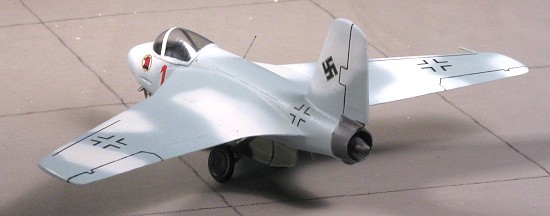 One
of the very nice things about this kit is that there really are not a lot
of parts. The majority of the airframe is already molded so all one has to
do is preparation and then jump into attaching bits. No subassemblies on
this one.
One
of the very nice things about this kit is that there really are not a lot
of parts. The majority of the airframe is already molded so all one has to
do is preparation and then jump into attaching bits. No subassemblies on
this one.
However, there is preparation. In addition to sanding off the mold seams (which are, in some cases, insignificant), this one was suffering from a myriad of pits on the upper surface of the wings. Undoubtedly caused by air bubbles or something, it looked like a car that had been through a hailstorm. Fortunately, it is easy to fix. I used Mr. Surfacer 500 and dabbed some on each and every pit I found. This was then sanded off and repeated if needed. It did fill in some panel lines and other detail was sanded away, but no new bubbles appeared during sanding (which sometimes happens with lesser resin kits). I rescribed what I could and then removed the fuselage from the rather large pour stub. The only bit that needs to be sawn off is the tail section. The rest can be removed with a sharp knife.
 I
then got the nose and tail sections cleaned up and attached them to the
fuselage. These were larger than the fuselage. No way to really fix things
other than attach them the best I could and then start sanding.
Fortunately, the Airmodel Resin is pretty much air bubble free so even some
rather deep sanding didn't have any of these pests show up. It took a bit
of work and when done,
I
then got the nose and tail sections cleaned up and attached them to the
fuselage. These were larger than the fuselage. No way to really fix things
other than attach them the best I could and then start sanding.
Fortunately, the Airmodel Resin is pretty much air bubble free so even some
rather deep sanding didn't have any of these pests show up. It took a bit
of work and when done,
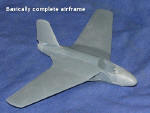 filler was added to handle any gaps. The fin
was cut off and as usual, I rounded the forward section of it when sanding
it 'flat' This was attached using lots of super glue, putting on extra
where there was a gap. It may be that this piece is a bit too long or that
the exhaust fairing extension is too short, but the rudder sticks out past
the little fairing on the exhaust piece.
filler was added to handle any gaps. The fin
was cut off and as usual, I rounded the forward section of it when sanding
it 'flat' This was attached using lots of super glue, putting on extra
where there was a gap. It may be that this piece is a bit too long or that
the exhaust fairing extension is too short, but the rudder sticks out past
the little fairing on the exhaust piece.
 During this, I guess I knocked a chip out of an aileron. Looks nasty,
but is really quite easy to fix. First, cut a slightly larger section out
of the area to be repaired. Often it is much easier t
During this, I guess I knocked a chip out of an aileron. Looks nasty,
but is really quite easy to fix. First, cut a slightly larger section out
of the area to be repaired. Often it is much easier t o fix something large
than something small. Then I cut a section of thin plastic card to fit into
the notch. I left a goodly sized piece in place to make it easier to work
with. This was affixed using super glue. Once it had dried, I took several
grades of sanding stick and slowly sanded the patch down to match the rest
of the aileron. Since it was at the edge, I didn't do much damage to the
detail on the aileron. One does have to be very careful while sanding not
to overdo it and cause problems with the surrounding area. Having done this
quite a few
o fix something large
than something small. Then I cut a section of thin plastic card to fit into
the notch. I left a goodly sized piece in place to make it easier to work
with. This was affixed using super glue. Once it had dried, I took several
grades of sanding stick and slowly sanded the patch down to match the rest
of the aileron. Since it was at the edge, I didn't do much damage to the
detail on the aileron. One does have to be very careful while sanding not
to overdo it and cause problems with the surrounding area. Having done this
quite a few
 times, I managed to pull it off without any glitches.
times, I managed to pull it off without any glitches.
Turning to the interior, I started adding pieces. First the nose wheel hump (which is a bit narrower than the hole in the floor it has to cover), then the instrument panel, rudder pedals, and control stick were glued in.
I then started trimming the canopy. Getting it to fit wasn't very easy as it seems to be a tad short. I wish I had a second one to use as I could use it to replace the one I seem to have messed up. Note to all who supply vac canopies. Include a spare!!!!!!!!! Bump the price up a couple of pennies if you have to. Many of us won't mind and we often could use it.
| COLORS & MARKINGS |
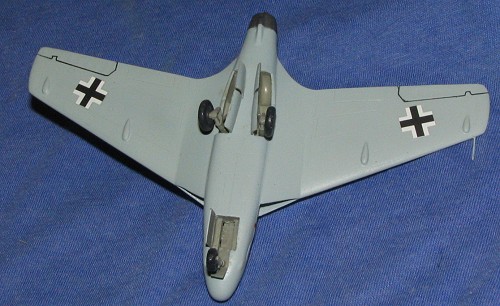 At
this time, I thought I'd start doing some painting. I first removed the
landing gear and wheels from their sprue stubs and cleaned them up. Two of
the three wheels were a bit thicker on one side than the other, being sort
of pear shaped when looked upon from the end. Creative mounting will take
care of this. Again, all I needed was a sharp knife to remove the bits from
the sprue.
At
this time, I thought I'd start doing some painting. I first removed the
landing gear and wheels from their sprue stubs and cleaned them up. Two of
the three wheels were a bit thicker on one side than the other, being sort
of pear shaped when looked upon from the end. Creative mounting will take
care of this. Again, all I needed was a sharp knife to remove the bits from
the sprue.
I painted the gear legs, wheel wells, and inner gear doors with RLM 02. The cockpit got a shot of RLM 66 and the wheels Weathered Black. After doing as much as I could on the canopy, that was attached and then masked. Then the airframe was painted overall RLM 76 and left to dry. Next, I sprayed a disruptive camo on the upper surface using white. Perhaps a bit of a cheat, but it is a scheme that isn't in with the rest of my Luft '46 aircraft collection. The exhaust area was masked around and painted Steel using Alclad II.
Back at the workbench, I drilled out the wheels and the strut location areas with a #56 drill bit. Then the wheels, which had the tires painted Gunze's Tire Black, were glued onto the gear struts. The main gear axles had to be trimmed a bit and the nose wheel was glued into the fork. Since one of the small stub axles on the nose gear was missing, the tire is basically glued to the top of the fork. Then the landing gear were cemented into place. I also installed the retraction struts on the main gear.
Next
were the gear doors. I glued these so that they retract from the center
outward instead of from the outside down. Just to be different. After all,
it is Luft '46 so there is no 'right or wrong' when it comes to these
things. I also glued on the radio mast and the pi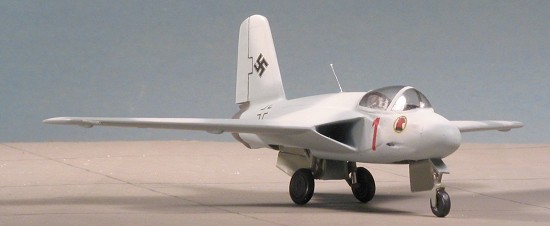 tot
tube. Then the kit was given a clear gloss coat to be ready for decals.
tot
tube. Then the kit was given a clear gloss coat to be ready for decals.
Decals for this kit will have to some from the spares bin. I have a number of sheets that are just Luftwaffe insignia and I pinched the other things like unit badges and numbers from a variety of sources.
Once those were in place and dry, the kit was given an overall clear matte coat. Now perhaps this aircraft would have been in a semi-gloss finish to enhance its speed, but I decided on the matte coat. The last thing I did was to pull off the masking from the canopy. Well, almost the last thing. I found out that the model was a borderline tail-sitter. Not having drilled out the nose cone for weight, I put a small one in the nose well and though it still has a propensity toward tail-heaviness, it isn't as bad as it was. I also broke the radio mast so replaced it with a section of wire.
| CONCLUSIONS |
This is not a difficult kit, thanks to its general simplicity. It is the perfect kit for those wanting a relatively quick build and a subject that is interesting and a bit different. I do wish that everyone included two vac canopies with their kits, but aside from that, this is one I can highly recommend for someone who is ready for a kit like this.
| REFERENCES |
Kit instructions, and my imagination.
September 2005
#1378 in a series
Copyright ModelingMadness.com. All rights reserved. No reproduction in part or in whole without express permission from the editor.
My thanks to Airmodel for the review kit. You can order direct from www.airmodel.de
If you would like your product reviewed fairly and quickly, please contact me or see other details in the Note to Contributors.